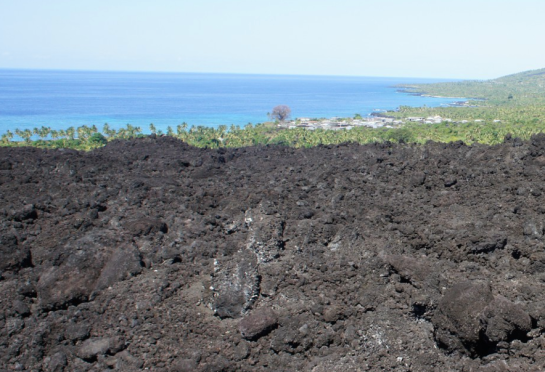To download the Q-LavHA tool, please read the info and fill in the form below to proceed to download.
Q-LavHA
Q-LavHA (Quantum-Lava Hazard Assessment) is a QGIS (Quantum Geographic Information System) freeware plugin which simulates ʻaʻā lava flow invasion probability from one or regularly distributed eruptive vents on a Digital Elevation Model. It combines existing probabilistic and deterministic models (Felpeto et al., 2001; Harris and Rowland, 2001) and proposes some improvements to calculate the probability of lava flow spatial propagation and terminal length. The spatial spread is constrained by the probabilistic steepest slope following the approach of Felpeto et al. (2001). Corrective factors are included to allow the lava flow simulation to overcome small topographical obstacles and fill pits. The terminal length of the lava flow simulation can be determined based on fixed length values, a statistical length probability function or based on the thermo-rheological properties of an open-channel lava flow following the approach of the FLOWGO model (Harris and Rowland 2001).
Q-LavHA is designed for scientists and stakeholders confronted with imminent or long-term lava flow hazard from basaltic volcanoes. Q-LavHA can improve their understanding of the spatial distribution of lava flow hazard, influence their land use decisions and support evacuation planning during a volcanic crisis. Because of the diversity of its uses, Q-LavHA has been developed in Python in order to allow users to adapt the code to their needs. Its availability as a Quantum GIS plugin with a user friendly interface facilitates its distribution and its use by the community.

NEW PLUGIN VERSION AVAILABLE
A new version of the plugin is now available (version 3.0). What is new in Q-LavHA 3.0?
- Q-LavHA runs in the last released version of QGIS.
- It is easy to install. The user must download the zip file after registration on the Q-LavHA website and install the plugin through the QGIS interface.
- An additional lava flow length constraint is available in this new release: the Euclidean length. When the Euclidean option is selected, the simulation stops when the lava flow line reaches a distance calculated as the crow flies’ distance between the point where the simulation starts and the front of the flowline. The previous maximum length lava flow length constraint is now renamed the Manhattan length which represents the travel distance covered by the lava flow line.
- The lava flow inundation probability parameter accepts float numbers.
- To help the users to select the best parameters for their simulations, additional fitness indexes have been integrated into the plugin.
- Moreover, the users can straight away realize a sensitivity test.
- If requested, a table and a graph summarizing the fitness indexes calculated at each stage of the sensitivity test can be produced. This enables users to quickly interpret their results.
- The input parameters have been reorganized in the interface to provide a more user-friendly interface.
- New keyboard short cut to start the simulations: Ctrl+R.
- YouTube videos are available to help you to realize your first simulations.
DOWNLOAD AND REFERENCES
In order for us to gain insight on the applications and study areas in which Q-LavHA is used, we kindly request to complete the registration form to the right in order to download the Q-LavHA plugin 3.0 [Windows/Mac]. Please cite the usage of the plugin accordingly (see below).
PLUGIN
- Q-LavHA manual 3.0----------------------------------- [download] (999.5 KB) "pdf"
- Data set----------------------------------------------- [download] (173.84 KB) "File"
The probabilistic lava flow map produced by Q-LavHA should be interpreted with care. Q-LavHA is a plugin which attempts to approach the reality of a channelized ʻaʻā lava flow inundation as accurately as possible. However, the outcome of the simulation depends on the quality of the DEM used and the selected simulation parameters. The probability of being inundated has to be interpreted as having a higher or a lower chance to be inundated. We consequently recommend the users to interpret the results as the sum of the trajectories a flow can potentially follow if an eruption occurs. More detail and recommendations can be found in Mossoux et al. (2016).
SOFTWARE
Q-LavHA has been designed to run in QGIS. Therefore, it is compulsory to install QGIS (minimum version 3.0) before installing Q-LavHA. All the information you need to install the plugin in QGIS is describe in the user manual
- QGIS--------------------------------------------------[download]
YOUTUBE
Do you need any help with the plugin? Watch our YouTube movies:
- How to install the plugin: https://www.youtube.com/watch?v=RoHpKosGrFU
- How to simulate your first lava flow: https://www.youtube.com/watch?v=w9UM63nVheI
SUGGESTED CITATION
Mossoux, S., Saey, M., Bartolini, S., Poppe, S., Canters, F., Kervyn, M., (2016). Q-LAVHA: A flexible GIS plugin to simulate lava flows., Comput. Geosci., 97, 98–109. doi:10.1016/j.cageo.2016.09.003
USEFUL REFERENCES
Bartolini, S., Cappello, A., Marti, J., Del Negro, C. (2013), QVAST: a new Quantum GIS plugin for estimating volcanic susceptibility. Nat. Hazards Earth Syst. Sci. 13, 3031-3042
Felpeto et al. (2001), Assessment and modelling of lava flow hazard on Lanzarote (Canary Islands), Nat. Hazards, 23, 247-257
Harris and Rowland (2001), FLOWGO: a kinematic thermo-rheological model for lava flowing in a channel, Bull. Volcanol., 63, 20-44
Tarquini, S., Favalli, M. (2011), Mapping and DOWNFLOW simulation of recent lava flow fields at Mount Etna, J Volcanol Geotherm Res, 204, 27-39
Sobradelo, R., Bartolini, S., and Marti, J. (2014), HASSET: a probability event tree tool to evaluate future volcanic scenarios using Bayesian inference presented as a plugin for QGIS. Bull. Volcanol. 76, 770
FURTHER CONTACT
[Matthieu Kervyn] - Lecturer in Physical Geography VUB